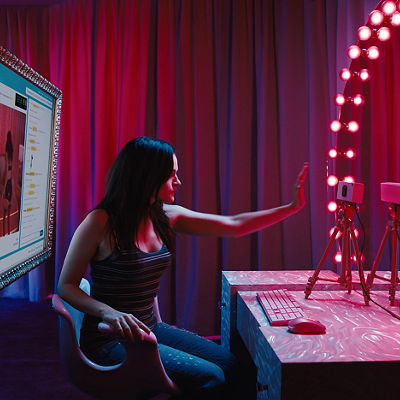On that fateful evening, the Lumiere brothers presented the first recorded public exhibition of an amazing new form of entertainment: the motion picture.
Two days later, Paris newspapers weighed in with the first recorded movie reviews. Le Radical hailed the Lumieres' "cinematographie" -- the device that recorded and projected the moving images -- as "certainly one of the most curious things of our era .... Whatever the scene shot in that way, and however many people thus caught unaware in the doings of their life, you see them again, in natural size, with the colors, the perspectives, the distant skies, the houses, the streets, with every illusion of real life." La Poste concurred, adding, "It's life itself; it's movement taken from life."
Many of the same films featured in that epochal premiere program can be viewed this Thursday at the Museum of Fine Arts, as French filmmaker Bertrand Tavernier co-hosts 100 Years Ago: Lumiere! The 7:30 p.m. program will feature 79 short films by the Lumiere brothers, along with a running commentary by Tavernier, president of the Lumiere Institute in Lyon, France, and Thierry Fremaux, the institute's artistic director.
Among the many cinematic firsts on the program are L'Arroseur Arrose, one of the earliest film comedies; Workers Leaving the Factory, the very first Lumiere production; and L'Arrivee d'un Train, a movie that so shocked audiences unaccustomed to motion pictures that many fled the theater in panic.
"Actually," Tavernier notes, "the whole program is a shock. It's amazing to see in these films, films that were made as far back as 1895, the beauty of the image, the beauty of the filmmaking.
"Louis Lumiere was a great photographer. And he was facing some extraordinary technical challenges. All of the films then were only 17 meters long -- 50 seconds. So when he was filming something, he had to make his point in 50 seconds. No more.
"And I think that, all of the time, he was always putting the camera in the best place. At the place where you could get the vision of what was important during those 50 seconds. I mean, there are several films where the camera is so well placed, the setup is so great, it reveals an eye which is incredibly modern."
At first glance, most of the Lumiere films appear to be only slightly more sophisticated than early still photographs. They consist of single fixed shots, recording fragments of the most mundane activities: workers leaving a factory, a train arriving at a station, parents trying to feed a baby. But in capturing these seemingly ordinary images, the Lumiere brothers blazed a trail that later generations of filmmakers would follow.
Tavernier remembers that when he and Fremaux presented a program of early Lumiere shorts to an audience of international filmmakers in Lyon last year, "Stanley Donen came up to me and said, 'The whole of cinema was already there in their films!' And he's right. Everything is there. The close-ups, the tracking shots, the use of medium shots, the social description, the social commentary, the fun, the comedy -- it's all there. In movies made 100 years ago."
Last September, Tavernier and Fremaux brought their Lumiere program to the Telluride Film Festival, where the response was, if anything, even more enthusiastic. "Werner Herzog told me this was the greatest shock he's had in the last ten years," says Tavernier. As a result, Kino International offered to send Tavernier and Fremaux on an eight-city tour with the shorts. Later, Kino will distribute a package of the Lumiere films, with a soundtrack of commentary by the two cineastes. "They also will release it on laserdisc, and maybe television," Tavernier says. "But it really should be seen on the big screen."
"You see," he adds, "we both think the Lumieres should be known not as the inventors of the moving image, but the inventors of cinema. The moving image was invented by people like Marey, Muybridge -- and, of course, Edison. But, as I always say when I present the show, Edison invented the pay TV, and the Lumieres invented the cinema. The same technique, but a different philosophy. Edison thought it would be more profitable to keep that image in a box, where one guy would have to put a nickel in to see the image moving. The idea of the Lumiere brothers seemed to him very bad, because they were showing that image to many people at the same time. For him, this meant less of a profit."
Truth to tell, the Lumiere brothers were singularly inept as businessmen. But they were visionaries when it came to recognizing cinema as an international language.
"Five months after doing their first films in the streets of Lyon, and photographing workers coming out of the factory," Tavernier says, "the Lumiere brothers had the brilliant idea of sending cameramen throughout the world, to film the streets of many other cities. This was such a great philosophical idea.
"I mean, can you imagine? In 1896, people of Bombay and Buenos Aires were seeing films of the streets of Paris, of Moscow. It's incredible. And that's what we want to celebrate. Because that's really what filmmaking should be about -- to bring the world to the world."
To give a sense of how the world ultimately responded, Tavernier got approximately 40 modern filmmakers to agree to use a Lumiere camera to make their own films. Accepting the technical and time limitations imposed on Louis Lumiere himself, the filmmakers produced a fascinating series of short films that are included in Lumiere and Company. The anthology will have its Houston premiere at 2 p.m. Saturday at the MFA. Among the directors represented are Spike Lee, David Lynch, John Boorman and Claude Lelouch, the last of whom managed to compress the entire history of cinema into one bold and beguiling 50-second lesson. Lelouch's less-than-a-minute masterpiece is even more proof, as if we needed it, that 100 years on, what still matters most in filmmaking is what the Lumiere brothers unquestionably had: vision.
100 Years Ago: Lumiere! will show at 7:30 p.m. Thursday, April 4, at the Museum of Fine Arts, 1001 Bissonnet, 639-7531.





